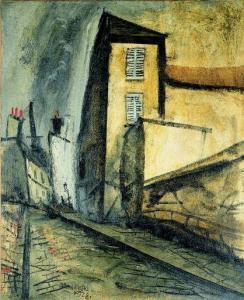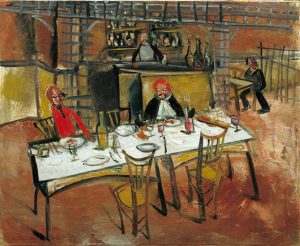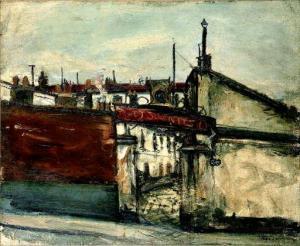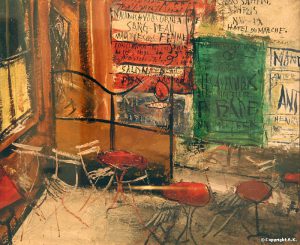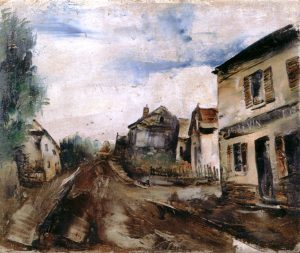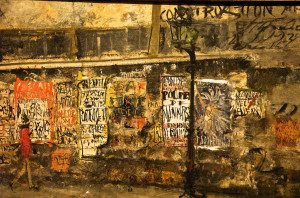Yuzo Saeki and Art of Japan: France, Poor Health, and Isolation in Paris
Lee Jay Walker
Modern Tokyo Times
Yuzo Saeki was born in 1898 and died in 1928 at the tender age of 30 but despite his short time on this earth he left a rich legacy. He was born in Osaka which is a vibrant city in Japan and from an early age he was besotted by art. His father was a Buddhist priest and with all the changes taking place in Japan during the Meiji and Taisho era, then this was a great time to experiment with different art styles.
In the Edo period, the rich traditions of art from China and Korea maintained its vitality despite major restrictions being imposed on the people of Japan during this period of history. However, influences from other nations did creep into Japan and this notably applies to art from Holland because of “a window” that was kept open in Nagasaki. Therefore, before the Meiji Restoration of 1868 many artists in Japan had been influenced by artists from Western nations. In time, many European artists would become influenced by Japanese art, therefore, fusions would develop between both distinctive cultures.
Another great artist called Ito Shinsui (1898-1972) was also born in 1898 like Yuzo Saeki and both artists produced stunning art. Ironically, while poverty led to the start of a bright career for Ito Shinsui after his father became bankrupt, the other side of the coin would beset the final years of Yuzo Saeki.
Ito Shinsui had been forced to abandon school at an early age because of monetary problems but this led to his talent being unearthed after taking up an apprenticeship at a printshop. However, while poverty opened up a new world for Ito Shinsui the opposite would engulf Yuzo Saeki during a period of terrible health. Therefore, these negatives conspired together and at the age of 30 Yuzo Saeki died in destitution in a mental hospital in France. The culmination of tuberculosis, a nervous breakdown brought on by overwork, limited means to survive, still painting outside despite worsening health conditions and other factors – all this led to a very sad ending.
Yuzo Saeki died in terrible circumstances in 1928 and this was a far cry from 1917 when he moved to Tokyo and all seemed calm in his life. He had been influenced greatly in his early years by Kuroda Seiki and studied under Takeji Fujishima in the capital of Japan. Within a few years of living in Tokyo, he got married in 1921 to Yoneko Ikeda who was also a fellow artist. Therefore, this period of his life was on an upward curve and in 1924 he moved to France to further his career with his wife and young daughter.
However, while the move to France was an all too familiar path for many international artists in this period, it also could be a pitfall given the cultural differences and thought patterns of Japan and France. Michael Brenson commented in the New York Times that “When European art began to question its own traditions, however, as it did increasingly during and after World War I, there was a potential for trouble. Artists could find themselves with neither a European tradition to learn from nor a Japanese tradition to hold onto. When Saeki Yuzo, who is perceived in his country as a tragic hero, the Japanese van Gogh, died at the age of 30 in an insane asylum in Paris in 1928 – perhaps a suicide – he had been trying to paint in this void. Saeki continues to be an example to Japanese artists abroad of the difficulties in reconciling East and West.”
Further down in the same article by Michael Brenson titled “When Japan’s Art Opened to Western Winds,” he comments that “Saeki Yuzo went to Paris with his family in 1924. His paintings reflect his isolation. His cafe windows and stores are filled with signs, some illegible. In his ”Snowy Landscape,” figures are on the verge of illegibility. His signs seem like scars of an internal pressure to resolve a conflict between the independence and picturesque subject matter of Paris and a dependence upon his native calligraphic and woodcut tradition.”
These words by Michael Brenson highlight the major problems facing artists like Yuzo Saeki in this period of history. Also, given the climatic reality of worsening his tuberculosis, suffering from a mental breakdown and dying destitute in a mental hospital; then it would appear that his ultimate demise was part self-induced, part tragedy, and fused with huge cultural differences and heavy demands that took its toll on both his body and mind.
Of course, many bright moments must have happened in France because he couldn’t wait to return. However, ultimately many factors would conspire and his life would be cut short. Therefore, people can only guess what his real legacy would have been if the cards had fallen kindly.
Matthew Larking in The Japan Times comments in his final paragraph that: “In France, Saeki was a progeny; in Japan, an innovator. Modernism was generally at the mercy of the culture looking at it. Saeki’s essential contribution, while very short-lived, was to usher in a period in Japanese Modernism that overthrew the pre-existing reliance on the Impressionist model and encouraged freer Fauvist Expressionism.”
However, despite all the artistic, political and cultural convulsions that befell Yuzo Saeki, along with suffering from tuberculosis, he still produced some truly amazing art. Therefore, the real tragedy of the life of Yuzo Saeki is that he didn’t have enough time to escape the trappings of two cultures that were pulling away at his artistic soul.
http://www.art.com/gallery/id–a228566/yuzo-saeki-posters.htm
http://www.nytimes.com/1987/12/25/arts/when-japan-s-art-opened-to-western-winds.html
http://www.japantimes.co.jp/text/fa20070301a1.html
Modern Tokyo News is part of the Modern Tokyo Times group
DONATIONS to SUPPORT MODERN TOKYO TIMES – please pay PayPal and DONATE to sawakoart@gmail.com
http://moderntokyotimes.com Modern Tokyo Times – International News and Japan News
http://sawandjay.com Modern Tokyo Times – Fashion
https://moderntokyonews.com Modern Tokyo News – Tokyo News and International News
http://global-security-news.com Global Security News – Geopolitics and Terrorism
PLEASE JOIN ON TWITTER
https://twitter.com/MTT_News Modern Tokyo Times
PLEASE JOIN ON FACEBOOK
https://www.facebook.com/moderntokyotimes
Some Japanese art and cultural articles are republished in order to inform our growing international readership about the unique reality of Japan.
